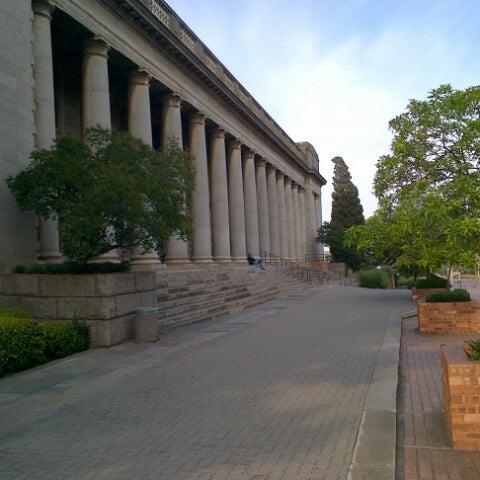In one of my blogs last year, I took a visit to the Flower Hall at Wits University which is an award-winning adaptation of an old exhibition building into a stunning exam venue. Today we walk across to the original East Campus, down the hill towards the sports fields, to look at a small gem of a building that has seen several adaptations for vastly different uses.
 |
| Approach to the WCCO from the west |
The building started life as a cricket pavilion, designed by the Professor of Architecture, Geoffrey Pearse, who had been appointed in 1922 when the University of the Witwatersrand began. Prof Pearse will be remembered for his publication on Cape Dutch Architecture, the result of a field trip with a group of students who were to play a central role in introducing Modernism to South Africa, including Rex Martienssen and John Fassler. The cricket pavilion, designed in the 1920s, had a symmetrical design, centred on a curved colonnaded verandah facing the cricket field, and crowned with a small turret.
Over the years, the building became dilapidated and was being used largely as a store room and change rooms for the grounds staff. In the late 1970s, Amancio "Pancho" Guedes, the Head of School of Architecture at the time, was appointed to renovate the building to create a multi-faith prayer space, renamed The Sanctuary. The floor level of the verandah was raised and the verandah enclosed to enlarge the central prayer space. The distinctive "Pancho" wooden skirting boards with their generous curves, are still visible.
By 2019, the Wits Citizenship and Community Outreach (WCCO) had moved into the building, providing meals for needy students, a food bank and a clothing bank for donated garments. The area around the building has been developed as a food garden to supplement the food donated for the kitchen. The exterior of the building has been enlivened with colourful murals, although the decorative plasterwork at the entrance and the turret have been preserved.
 |
| The WCCO entrance from the south |
This brings me to a consideration of adaptive re-use of buildings, a topic that is very close to my heart and has played a role throughout my practice as an architect. Wits University has a very good track-record of building re-use, of both its historical buildings and the ones of later date and more ambiguous architectural and historical merit.
An example of one of the older buildings is the original Engineering Building (now called South-West Engineering), that originally housed the entire Faculty of Engineering. Many of the Schools in this Faculty have now been decanted into their own buildings, the first of which was the Hillman Building dating from the 1940s, which houses the School of Civil and Environmental Engineering. The original Engineering Building has been adapted to house the School of Mechanical, Aeronautical and Industrial Engineering on the upper floor, with some sensitive adaptation of the spaces to modernise the lecture facilities. The laboratories for this School are in a separate building to the north.
 |
| Wits original Engineering building, now South-West Engineering Creative commons licensed: https://foursquare.com/v/south-west-engineering-building/4cee6cae51785941a0a2bc8f |
Comments
Post a Comment